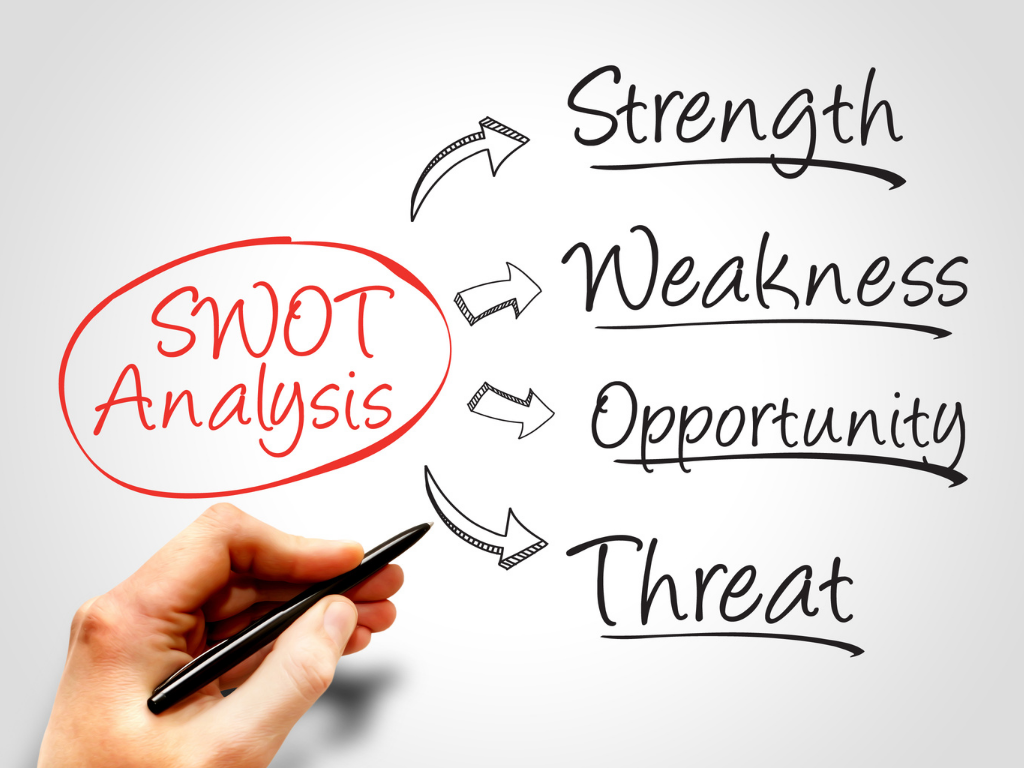Businesses need to come up with their reasons in the beginning and then set clear goals to survive and thrive. With the cut-throat competition in the market to attract more customers, data is the new commodity. Through data, companies collect, analyze, and interpret their growth and challenges as well as that of their competitors.
When looking internally, companies need to keep tabs on their corporate health. Many tools can draw a clear and discernible picture of their business for them. One of these tools is a SWOT analysis.
SWOT analysis paints a very clear picture of the current health and challenges a company could face. That’s why before conducting one, businesses and organizations should not count preexisting beliefs and value gray areas with great precaution.
What is SWOT Analysis Paper?

SWOT Analysis is a planning tool that offers strategic insight to a business regarding its (S)trengths, (W)eaknesses, (O)pportunities, and (T)hreats – hence the name SWOT!
The rationale behind conducting SWOT Analysis is to get a realistic take on both internal and external conditions a business could be facing and to determine a future course of action. Since it takes many input streams to gather and analyze the four cardinal indicators, it is best if a company involves diverse and even diverging sources to get well-grounded data.
Since own SWOT Analysis tries to assess current market trends and causes to predict future outcomes, the results from any study should be taken with a pinch of salt and then adjusted accordingly.
The best thing about SWOT Analysis is that it can be done at a larger business or industry level and on a smaller scale, such as a product line or subsidiary. That’s why businesses spend a big portion of their budget to write a SWOT Analysis report to get a competitive edge against their competitors.
Importance of SWOT Analysis
SWOT Analysis can help businesses in project planning for future outcomes and overcoming challenges and threats through the strategic planning process. It gives a clear view of what are the comparative advantages a business is enjoying and the opportunities it can explore based on those advantages. On the other side, it gives indications where a business could be facing disadvantages comparatively and serious issues that can materialize based on them.
Following are some of the points that highlight the importance of SWOT Analysis:
- Customizable According to Purpose
- Helps Fortifying Strengths
- Keeps Disadvantages at Bay
- Highlights Opportunities
- Neutralizes Threats
Customizable According to Purpose
At first, SWOT Analysis was only conducted by businesses for very obvious reasons. Later, it was adopted by governments and regulatory bodies to gauge the current and future potential of economic indicators. Now, even entrepreneurs and investors conduct a personal SWOT analysis before making investment decisions.
SWOT Analysis can be tailored and customized according to the question or purpose that the party wants to be answered.
Helps Fortifying Strengths
At the decision-making level, there are always trade-offs and one side gets the best end of the bargain. Businesses make sure they do not cut off profit-making sectors and product lines because of poor insight. This is where SWOT Analysis help them identify the strengths or comparative advantages their businesses have over competitors or throughout the industry.
Keeps Disadvantages at Bay
In the same manner, SWOT Analysis can help stakeholders identify weaknesses in the business. These could be internal or external, mostly the former. By identifying these, managers are in a better position to minimize their effects in the short term and even root them out in the long run.
Highlights Opportunities
In businesses, a missed opportunity is a big loss. This is where SWOT Analysis shines through. Providing a realistic look at the internal factors and how companies can employ them for an external advantage or an opportunity, helps businesses in capturing opportunities to make big profits early on.
Neutralizes Threats
Things that can disrupt the advantages a business has outside of the company can be termed as external potential threats. Threats are external and can be caused by changes in the industry or a competitor’s business. Through SWOT Analysis, companies can identify these threats and neutralize them before they can cause more damage.
What Are The Four Parts Of A SWOT Analysis

The researchers usually employ a four quadrants approach to describe and detail SWOT Analysis. This way, it looks into all of the elements with necessary questions answered in a precise fashion.
The term SWOT Analysis is made up of four elements:
- Strengths
- Weaknesses
- Opportunities
- Threats
Strengths
Strengths describe what works well for a company. It can be a strong brand, a loyal customer base, an effective marketing strategy, and so on. They often shed light on what a business is doing and how it is doing it. In addition to this, strengths are multidimensional as they not only maximize profits in the short run but also contribute to the expansion and growth of a company.
Weaknesses
Companies need to operate at an optimum level to maximize their profits. Weaknesses are all the negative factors that can stop them from doing so. The most common examples of weakness in a company can be a high turnover of employees, high levels of debt, inadequate capital, etc.
Opportunities
Opportunities, as the name indicates can be an incident or a setting that gives a window for competitive advantage to a business. These could be at the business level or even the state level. For instance, if a country revised the tax and excise structure for imports, it can help foreign companies to entice customers into buying their products.
Threats
Anything that can disrupt the status quo for a business, assuming the business was doing very well, can be a threat. Developments and incidents in the external business environment can lead to dropping in profit margins, company outlook, environmental factors, etc. The most common threats that businesses face include the rising cost of materials, increasing competition, and so on.
SWOT Internal and External Factors: What to Include
In SWOT Analysis, all the four elements are often set in four-quadrant tables. This allows easy access and a following of the table based on the information given in each of the quadrants. Besides this, there is another distinction between elements.
- Internal Factors
- External Factors
Internal Factors
Strengths and weaknesses are often described under internal factors. Since these can be directly gauged and adjusted by the companies with no almost no external influence on them. These internal strengths include financial and human capital a company possesses, assets and patents, and so on.
External Factors
Companies do not operate in a vacuum. The external environment or factors that affect business operations are compiled under external factors. These include opportunities and threats that a company faces, such as changes in tariff structure, access to exclusive suppliers, etc.
SWOT Analysis Essay Format
Writing a SWOT Analysis paper can be scary for someone who hasn’t done it before. There are so many variables and anything can go wrong which can affect the results interpreted from the analysis. There is also a risk of creating clutter or informational bottlenecks which could lead to overall poor quality of the essay.
Here is an outline to present a SWOT Analysis essay format that students and researchers can take advantage of:
- Company Details
- SWOT Analysis
- Strengths
- Weaknesses
- Opportunities
- Threats
- SWOT Table
- Concluding Remarks
SWOT Analysis Essay Examples
Another way of learning how to write an example of a SWOT Analysis paper is by going through the already published examples. They are often done by professional writers with ample experience and expertise in the industry. With clear objectives and insights, these analyses cannot only help the intended audience but also students and young researchers to write a SWOT Analysis summary.
Following are some of the greatest SWOT Analysis essay examples you can find on the web:
- SWOT Analysis on Merck & Co. Inc.
- Premier Inn: Key Strategic Issues, Porter’s Five Forces, and SWOT Analysis
- Silver Airways LLC SWOT and Strategic Goals
- Walmart: SWOT Analysis and the Factors Influencing its Competitive Advantage
- FEMA SWOT Analysis
FAQs
What Are Examples Of Strengths In A SWOT Analysis?
When it comes to internal strengths in SWOT Analysis, all internal things that help a business in maximizing profits while giving them a comparative advantage over its competitors can be termed under the strengths table. Examples of strengths can be human and financial resources, proprietary operations and processes for improved efficiency, and so on.
What Is The Most Difficult Part Of The SWOT Analysis?
SWOT Analysis paper intends to give a clear picture of a business based on its internal and external factors. All the determinants and results on the availability of reliable, unbiased data. This is the most difficult part of SWOT Analysis – gathering and interpreting reliable data.
What Is The Most Important Part Of The SWOT Analysis?
While conducting SWOT Analysis, analysts should be aware of the direction of their research and the impact it will have on previous and future calculations. That’s why the direction of analysis in SWOT Analysis is the most important thing.
The best way to move forward is to start with internal factors – strengths and weaknesses, and then move to external factors – opportunities and threats.
Exclusive tips: Essays for sale offer customized, high-quality content designed to meet your academic needs and deadlines, helping you excel with expertly crafted papers.








